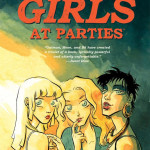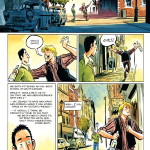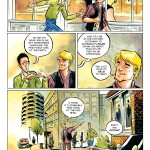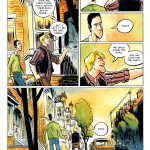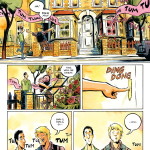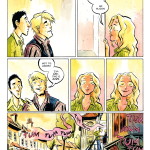Enn: “I don’t know what to say to girls.”
Vic: “They’re just girls. They don’t come from another planet.”
Awkward teenager Enn was already unhappy about being dragged to the local party by his confident friend Vic. He was even more uncomfortable when it turned out to be the wrong party. But Vic decided they were going to stay anyway. Because this party had lots of girls.
Enn didn’t have a lot of experience with girls, so he was going to have to stick to Vic’s suggestion: just try talking to them.
It sounds like a regular coming-of-age story (or at least trying to survive being a teenager with one’s sanity intact). And it is, sort of. Except for the fact that the girls at this party are from much further away than either boy realizes.
If you’ve been waiting for an excuse to read something by Neil Gaiman (or if you’re like me and you’ll read anything that has his name attached to it) then you might want to pick up this graphic novel adaptation of his short story How to Talk to Girls At Parties, with artwork by the incomparable Fábio Moon and Gabriel Bá.
To start with, Enn is a typical fifteen-year-old boy with a typical fifteen-year-old boy’s obsession with sex. Or rather, with girls, since he’s so bowled over by the entire concept of females that he hasn’t quite made the jump to the idea of ever having sex with one. So since he has a running monologue going on in his brain about how this girl is pretty, and this one is nice, and maybe he can be smooth and accidentally-on-purpose put his arm around her shoulders, he keeps missing the fact that there’s something rather odd about the people at this party.
And yet Enn doesn’t come across as creepy at all, because Gaiman has written him with a typical fifteen-year-old boy’s sense of being broken somehow, or at least unfinished and lonely. Being able to talk to girls is just one of the things he thinks he needs in order to figure out this whole growing-up deal. And since already feels like girls are an exotic species and impossible to understand, a lot of the…strange things they say to him go right over his head.
So the story itself is already one of my favorites, but then you add the artwork by Moon and Bá and you get something unique. The twin brothers’ style could almost be manga (especially the way they draw women’s eyes), except it’s much more angular and expressive. The coloring is done in a sort of hasty watercolor wash, with random splashes of paint that give a dreamy feel to many of the scenes.
I loved getting to see a different view of this story, with little details added like they way you can see that Stella is instantly delighted when Vic turns on the charm, or how Enn’s face falls when he sees the girl who (for reasons he doesn’t come close to understanding) was crying on his shoulder earlier, is now laughing with another boy. From his expression, I could imagine him thinking “Well of course he made her smile and I couldn’t. Because I suck.” But it’s the way the artists interpreted what each girl is saying that really drew me into this book.
Enn talks to three girls (or rather, they talk to him) and there’s a different style to each conversation. One story is told in a sunlit conservatory hung with lights and lanterns, and the girl talking is as sunny and cheerful as her surroundings. The next is in a dark library, with a girl who’s trying to be happy on a trip she really didn’t want to take, as she sees an ocean of fire in her water glass and the silhouette of her birdlike parent-teacher in the shadows cast by a single lamp.
But it’s the third story that’s my favorite. Moon and Bá pulled out all the stops with this one, covering entire pages with images of a lost civilization and a pattern in the stars, and a girl who’s also a poem that can change an entire world.
I’m still not entirely sure what happened in the end, or in what way Vic managed to screw up as badly as he did (the obvious idea is some attempt at force, but from his reaction I think he may have rejected Stella in probably the worst way he could have). The full-page picture towards the end made me wonder what happened to the party. And if anyone survived.
But most of all this graphic novel made me realize that every one of the dozens of people at this party had their own story. Each one would be as different from the lives of Vic and Enn as the first three girls were from each other. And there would have been some overarching reason for why all these otherworldly people were there, in that apartment in London, for a party.
That would be another Neil Gaiman story I’d love to read.
